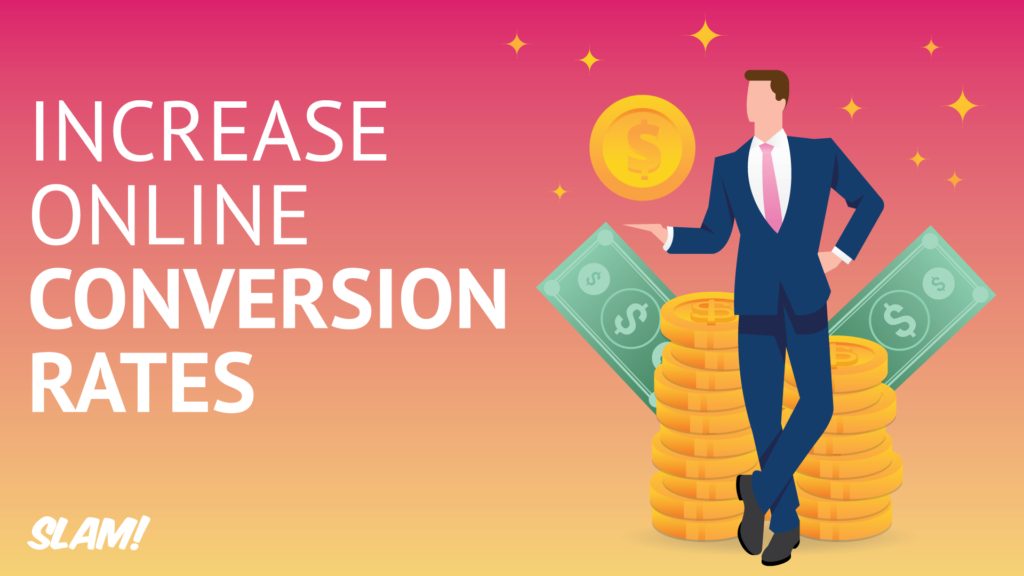How to Increase Online Conversion Rates

How are online sales of your product/service doing these days? If your answer was a truthful “couldn’t be better!”, then stop reading right this moment and go celebrate.
Still with us? Great! You are likely searching for insights into increasing your online sales. Perhaps you don’t have enough traffic to your site, but that’s a topic for another post.
It’s time to get more of the clicks that matter!
Want some help converting the existing traffic to your site to more sales – in other words, increasing your online conversion rate? Read on…
First, let’s make sure we are clear on exactly what a conversion rate is.
Each page should have one specific goal or desired action by the visitor – fill out this form, or watch this video, or buy this product (cha-ching!).
Take the total number of completed actions on a web page and divide by the number of visitors to that page. You’ll get a number somewhere between 0 and 1. Multiply by 100 to get your conversion rate percentage; so, if your number was 0.17, your conversion rate is 17%.
17% is not too shabby – conversion rates of 20-30% are generally accepted as decent. Obviously, the more visitors you are converting, the higher your ROI (Return On Investment), and the lower your customer acquisition costs.
In other words, higher conversion rates mean more $$ in the bank. And who doesn’t want that?
Sure, you say … but increasing conversion rates is undoubtedly a majorly complex process.
Nope, it’s actually quite simple. It’s all about content – more specifically, relevant content.
How do you make content relevant? Start by identifying where your audience is in their journey to becoming your customer.

Your customers will typically progress through four stages on their way to clicking “Buy Now” on your website’s checkout page. We refer to these stages as the 4 Stages of Awareness.
The 4 Stages of Awareness are:
- Not Aware
- Problem Aware
- Solution Aware
- Brand Aware
(Knowledge of these stages is vital, as you need to speak differently to customers in each of the four stages.)
Not Aware
All Not Aware types start off as potential prospects. These are people that are not aware of a problem, of a solution to that problem, or of your product or service that provides that solution.
For example, let’s say that you market iPhone repair services.
Research has shown us that, at any given time, 3% of the market is ready to buy NOW; 67% are not (yet) ready to buy (so, they are not aware of a problem, solution, or your brand), and the remaining 30% of the market are not your best prospects (write ‘em off!).
In our example, people that either don’t have a smartphone or have a non-Apple phone are not prospects. So, we’re not going after them.
Our tendency at times is to jump straight to the sale; this will not appeal to the 67% who are not ready to buy.
You must guide your prospects through the stages of awareness, utilizing a different approach for each.
Problem Aware
Don’t focus on Not Aware types, but rather on Problem Aware types.
Instead of convincing someone they need your service, you want to help those with a problem get better results through a better solution.
Talking to someone about a problem they don’t know that they have is not the most efficient use of your marketing resources.
Create educational, informational content (blog posts and videos) that would appear in organic search results (search example: “what causes vertical lines on my iPhone screen”).
This content should help the visitor diagnose their problem with a possible solution (*yours*).
Your goal for this page is to invite visitors to click to a solution-oriented page (not yet to a product/service purchase page).
Solution Aware
Solution Aware types are coming to your site with some knowledge of a solution.
Perhaps they clicked over from a Problem Aware page on your site; they also may have come directly from search results (as stated above).
In the example, perhaps a new screen might be needed, or maybe there’s a loose connection inside that needs to be tightened up. Your job here is to explain these possible solutions and their benefits and/or advantages.
Once you’ve done that, you can hit your visitors with “Here are some products/services that you might try”. One click away from the shopping cart!
Brand Aware
At last! Brand Aware types are ready to buy (whether they’ve clicked over from your Solution-oriented page or came directly from a search for your exact product/service name).
They’ve identified their iPhone problem as a faulty LCD connector, watched your video showing how the repair is done, and found that you can do it for them.
Having a healthy conversion rate is so important for marketing success: It increases your revenue per visitor and lowers your customer acquisition costs. Share on XThe bad news: they’re not all going to buy from you.
Why not? It could be one (or more) of a variety of reasons. Here are some you can influence:
- Your product is more expensive than the competition
- Your website delivers a bad UX (user experience)
- You’re trying to upsell right away (the ole’ Bait & Switch)
Your next mission, should you choose to accept it: eliminate any barriers, let the buyers buy, and watch your conversion rate grow!
Here's What Our Customers are Saying

Angela Caputa, Director of Marketing
Hoffmann Brothers

Travis Sheridan, Executive Director
Venture Cafe Global

Cyndie Roche, VP of Sales & Marketing
Payne Family Homes
